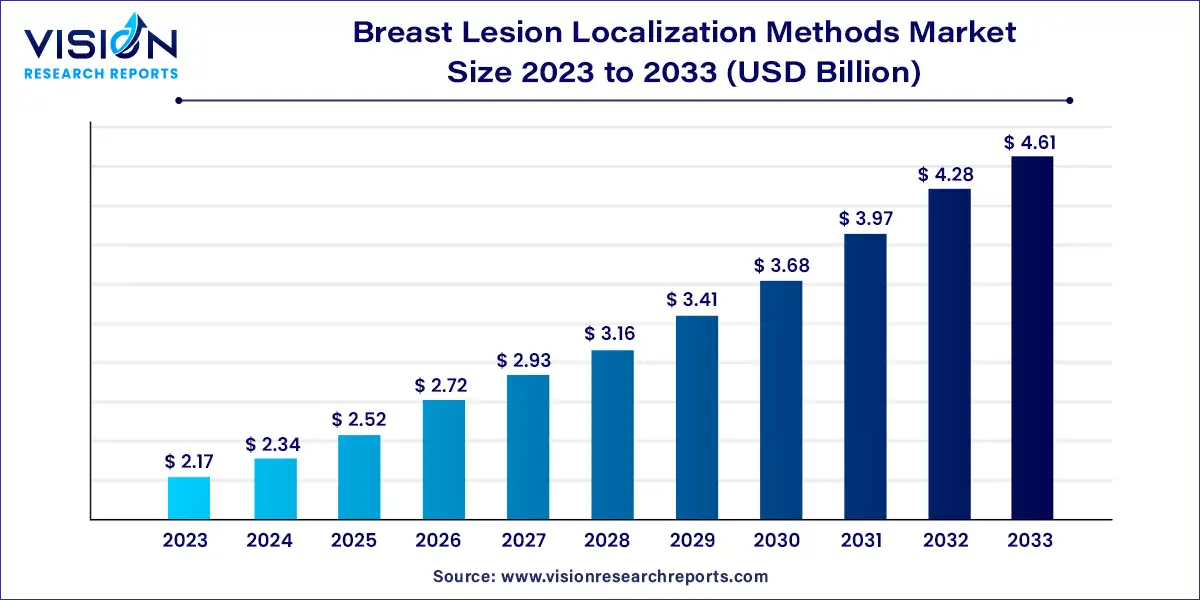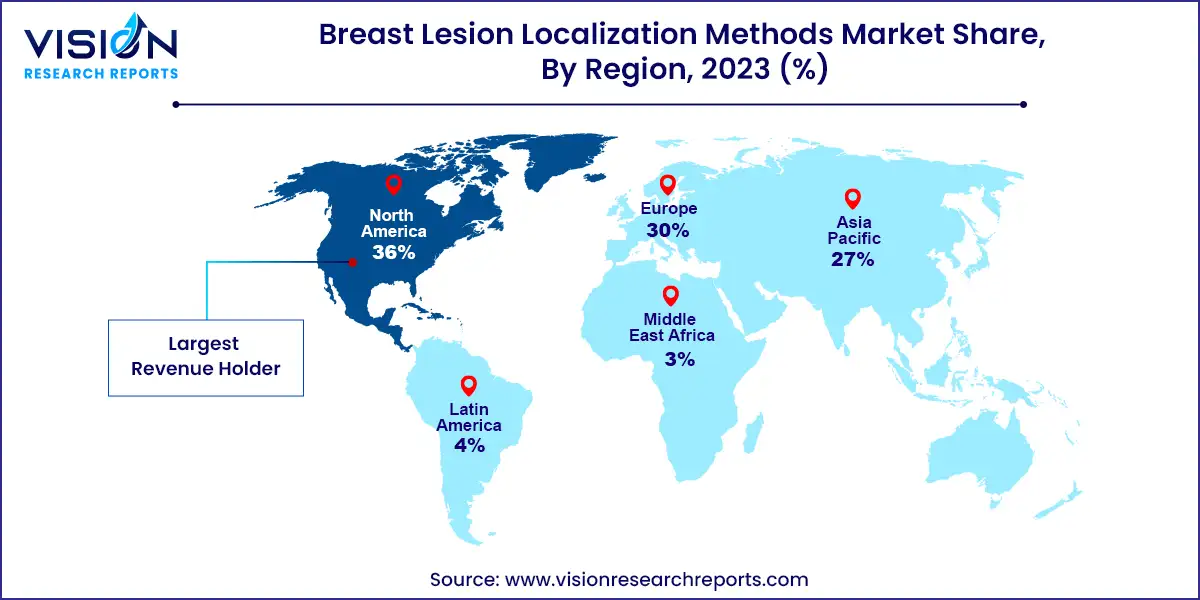The global breast lesion localization methods market size was estimated at around USD 2.17 billion in 2023 and it is projected to hit around USD 4.61 billion by 2033, growing at a CAGR of 7.83% from 2024 to 2033.

The breast lesion localization methods market is a critical segment within the healthcare industry, focusing on the accurate identification and localization of breast lesions. This market has gained significant attention due to the rising prevalence of breast cancer, advancements in diagnostic imaging technologies, and the increasing demand for minimally invasive procedures. The primary goal of breast lesion localization is to guide surgeons in precisely removing abnormal tissue while minimizing damage to healthy tissue, thereby improving patient outcomes.
The breast lesion localization methods market is experiencing significant growth primarily driven by the increasing incidence of breast cancer worldwide, which necessitates early detection and precise surgical intervention. Advances in diagnostic imaging technologies have enhanced the accuracy and reliability of lesion localization methods, further fueling market expansion. Additionally, the growing preference for minimally invasive procedures, which require precise lesion localization to optimize surgical outcomes, is boosting demand. Furthermore, rising awareness about breast cancer screening, coupled with government initiatives to promote early detection, is contributing to the market's robust growth trajectory.
In 2023, North America held the largest share of the global breast lesion localization methods market, accounting for 36% of total revenue. The region's strong market position is supported by its well-established healthcare infrastructure and the presence of leading manufacturers, particularly in the U.S. The ongoing technological advancements and high levels of economic development in North America are expected to continue driving market growth. Additionally, initiatives by both government and private organizations to raise awareness about breast cancer are likely to further bolster the market's expansion in the region.
| Attribute | North America |
| Market Value | USD 0.78 Billion |
| Growth Rate | 7.83% CAGR |
| Projected Value | USD 1.65 Billion |
The U.S. breast lesion localization methods market size was estimated at USD 0.54 billion in 2023 and it is expected to surpass around USD 1.16 billion by 2033, poised to grow at a CAGR of 7.83% from 2024 to 2033.
The U.S. market for breast lesion localization methods was the largest within North America in 2023. Factors such as the rising incidence of breast cancer, advancements in medical imaging technologies, increased awareness about early detection, and initiatives promoting regular breast screenings are key drivers of market growth.
Europe Breast Lesion Localization Methods Market Trends
In Europe, the market for breast lesion localization methods is shifting towards advanced imaging technologies to enhance lesion localization accuracy. There is a growing emphasis on minimally invasive biopsy procedures and an increased focus on the early detection and diagnosis of breast lesions. Additionally, the region is seeing a trend towards value-based healthcare and the integration of artificial intelligence in breast lesion localization, which are contributing to the market's growth in Europe.

Asia Pacific Breast Lesion Localization Methods Market Trends
The breast lesion localization methods market in Asia Pacific is poised for substantial growth, driven by factors such as rising disposable incomes, significant unmet clinical needs, and increasing patient awareness of the importance of early diagnosis. The region's rapidly advancing healthcare infrastructure and growing demand for breast-conserving surgeries are also expected to create significant growth opportunities. Furthermore, the rise in medical tourism in emerging APAC countries is contributing to the market's expansion in this dynamic region.
In China, the breast lesion localization methods market is undergoing a transition towards advanced technologies like MRI-guided localization and radioactive seed localization (RSL). This shift is being fueled by increased healthcare expenditures and a stronger focus on accurate breast cancer diagnosis and treatment. Government initiatives promoting early detection, the expansion of urban healthcare infrastructure, and the integration of digital health solutions are also key factors driving the market's growth in China.
In 2023, the wire-guided localization (WGL) segment led the breast lesion localization methods market, capturing the largest revenue share of 34%. This dominance is largely due to the early adoption and widespread use of WGL among healthcare providers. The cost-effectiveness of WGL also plays a significant role in its prevalence, as it remains more affordable compared to newer alternatives like radioactive seed localization (RSL) or MRI-guided techniques. This affordability is particularly appealing in healthcare settings where cost-efficiency is a priority. Moreover, the well-established reimbursement policies and regulatory approvals have further reinforced WGL’s position as a preferred choice for breast lesion localization worldwide.
WGL is highly regarded in the market for its reliability and broad clinical acceptance. The technique involves inserting a thin wire into breast tissue to accurately locate non-palpable lesions detected through imaging methods like mammography or ultrasound. Over the years, WGL has gained the trust of healthcare providers globally due to its consistent performance and familiarity.
Looking ahead, the magnetic tracer segment is projected to grow at the fastest CAGR during the forecast period. Magnetic tracer techniques, including MRI-guided localization, are favored for their superior precision and accuracy in localizing non-palpable breast lesions compared to traditional methods like WGL. This technological advantage makes them increasingly attractive to healthcare providers seeking enhanced localization accuracy.
Patients often prefer MRI-guided localization and other magnetic tracer methods due to the reduced discomfort compared to invasive approaches like WGL. This increased patient comfort can lead to higher satisfaction and may drive healthcare providers to adopt these advanced technologies, contributing to the segment's growth in the coming years.
By Type
By Region
 Cross-segment Market Size and Analysis for
Mentioned Segments
Cross-segment Market Size and Analysis for
Mentioned Segments
 Additional Company Profiles (Upto 5 With No Cost)
Additional Company Profiles (Upto 5 With No Cost)
 Additional Countries (Apart From Mentioned Countries)
Additional Countries (Apart From Mentioned Countries)
 Country/Region-specific Report
Country/Region-specific Report
 Go To Market Strategy
Go To Market Strategy
 Region Specific Market Dynamics
Region Specific Market Dynamics Region Level Market Share
Region Level Market Share Import Export Analysis
Import Export Analysis Production Analysis
Production Analysis Others
Others